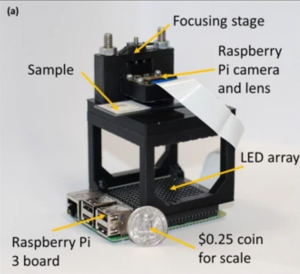There is a heavy need for low-cost, portable microscopes for medical purposes and disease prevention in communities with limited resources. Attempts at microscopy suited for these communities have previously resulted in images with a poor space bandwidth product (SBP). Unfortunately, a high SBP is essential for accurate identification of diseases or targeted cells in medical diagnosis. SBP can be improved with expensive equipment such as automated stages for mechanical scanning and a high quality lens, but these costly materials are not feasible for resource-limited communities.
This paper by T. Aidukas, R. Eckert, A. Harvey, L. Waller, and P. Konda proposes a low-cost, portable microscope with a high SBP using a 3D printed Fourier Ptychographic microscope (FPM) equipped with an LED array and a Raspberry Pi computer board and camera. Using this setup, multiple LR images are taken by the Raspberry Pi camera lens using oblique illumination angles from the LED array. Using the Raspberry Pi computer, a reconstruction algorithm can then stitch these multiple LR images into one HR image with a high SBP. The reconstruction algorithm can recover both amplitude and phase images, both of which are useful for interpretation of data, especially for transparent samples like living cells or tissues. The algorithm is also able to computationally calibrate illumination angles of the LED array, which corrects misalignment errors in the array that are inevitable with imperfect, 3D printed materials.

Previous attempts with 3D printed FPMs have used a mobile phone camera for imaging, but this also required an expensive monochrome color sensor and still resulted in a poor SBP. In this paper, the authors instead use a Raspberry Pi camera, which includes a low-cost Bayer color sensor and produces images with a much better SBP. In addition, the fact that the algorithm as well as control of the LED illuminations and camera is done by a Raspberry Pi computer is great for compactness and portability. Together, these materials allow for an inexpensive setup with high SBP, ideal for medical purposes in isolated, resource-limited communities.
References:
T. Aidukas, R. Eckert, A. Harvey, L. Waller, and P. Konda. “Low-Cost, Sub-Micron Resolution, Wide-Field Computational Microscopy using Opensource Hardware.” Scientific Reports 9. (2019)
